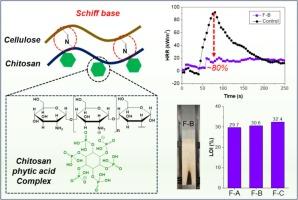采用希夫碱方法将壳聚糖-植物酸复合物用于阻燃棉织物
IF 5.8
2区 化学
Q1 POLYMER SCIENCE
引用次数: 0
摘要
在这项研究中,通过希夫碱反应将壳聚糖整合到棉织物纤维上,然后在原位生成壳聚糖-植酸(CH-PA)复合物,从而实现绿色阻燃。该工艺首先使用过碘酸钠(NaIO4)氧化织物,在纤维表面生成大量醛基。随后,通过希夫碱反应将 CH 接枝到织物上。然后将织物浸入 PA 溶液中,形成 CH-PA 复合物,从而制成新型高效阻燃(FR)织物。利用傅立叶变换红外光谱(FTIR)、扫描电子显微镜(SEM)和能量色散光谱(EDS)对处理后织物的结构进行了分析,证实成功形成了所需的结构。热重分析(TGA)、锥形量热仪(CONE)、垂直燃烧试验和极限氧指数(LOI)测量系统地评估了织物的热稳定性和阻燃性。当织物经浓度为 0.02 g/mL 或更高浓度的 NaIO4 溶液处理时,LOI 从 17.6 % 增加到 30.6 %,垂直燃烧测试表明其具有自熄能力。在 CONE 试验中,改性织物的性能有了显著改善,峰值热释放率(pHRR)和总热释放率(THR)分别降低了约 80% 和 60%。综合分析表明,阻燃机制涉及气相和凝聚相作用。材料的进一步表征包括拉伸测试和耐洗评估。通过将这些研究结果与近期类似课题的研究结果进行比较,对材料的优缺点进行了全面评估。值得注意的是,这项工作为棉织物的绿色阻燃提供了坚实的实验基础和概念拓展。本文章由计算机程序翻译,如有差异,请以英文原文为准。

Schiff base approach to introduce chitosan-phytic acid complex for flame-retardant cotton fabrics
In this study, chitosan was integrated onto cotton fabric fibers through a Schiff base reaction, followed by the in-situ generation of Chitosan-Phytic acid (CH-PA) complex to achieve green flame retardancy. The process began with oxidizing the fabric using sodium periodate (NaIO4) to create numerous aldehyde groups on the fiber surface. Subsequently, CH was grafted onto the fabric via a Schiff base reaction. The fabric was then immersed in a PA solution to form a CH-PA complex, resulting in a novel and highly efficient flame-retardant (FR) fabric. The structure of the treated fabric was analyzed by using Fourier-transform infrared spectroscopy (FTIR), Scanning electron microscopy (SEM), and energy-dispersive spectroscopy (EDS), confirming the successful formation of the desired structure. The thermal stability and flame retardancy of the fabric were systematically evaluated using thermogravimetric analysis (TGA), cone calorimetry (CONE), vertical combustion tests, and limiting oxygen index (LOI) measurements. The LOI increased from 17.6 % to 30.6 %, and vertical combustion tests demonstrated self-extinguishing capabilities when the fabric was treated by the NaIO4 solution at concentrations of 0.02 g/mL or higher. In the CONE test, the modified fabric showed significant improvements, with peak heat release rate (pHRR) and total heat release (THR) decreasing by approximately 80 % and 60 %, respectively. Comprehensive analysis indicated that the FR mechanism involved both gas phase and condensed phase actions. Further characterization of the material included tensile testing and wash resistance assessments. By comparing these findings with recent research on similar topics, the advantages and disadvantages of the materials were thoroughly evaluated. Notably, this work provides a robust experimental foundation and conceptual expansion for the green flame retardancy of cotton fabrics.
求助全文
通过发布文献求助,成功后即可免费获取论文全文。
去求助
来源期刊

European Polymer Journal
化学-高分子科学
CiteScore
9.90
自引率
10.00%
发文量
691
审稿时长
23 days
期刊介绍:
European Polymer Journal is dedicated to publishing work on fundamental and applied polymer chemistry and macromolecular materials. The journal covers all aspects of polymer synthesis, including polymerization mechanisms and chemical functional transformations, with a focus on novel polymers and the relationships between molecular structure and polymer properties. In addition, we welcome submissions on bio-based or renewable polymers, stimuli-responsive systems and polymer bio-hybrids. European Polymer Journal also publishes research on the biomedical application of polymers, including drug delivery and regenerative medicine. The main scope is covered but not limited to the following core research areas:
Polymer synthesis and functionalization
• Novel synthetic routes for polymerization, functional modification, controlled/living polymerization and precision polymers.
Stimuli-responsive polymers
• Including shape memory and self-healing polymers.
Supramolecular polymers and self-assembly
• Molecular recognition and higher order polymer structures.
Renewable and sustainable polymers
• Bio-based, biodegradable and anti-microbial polymers and polymeric bio-nanocomposites.
Polymers at interfaces and surfaces
• Chemistry and engineering of surfaces with biological relevance, including patterning, antifouling polymers and polymers for membrane applications.
Biomedical applications and nanomedicine
• Polymers for regenerative medicine, drug delivery molecular release and gene therapy
The scope of European Polymer Journal no longer includes Polymer Physics.
 求助内容:
求助内容: 应助结果提醒方式:
应助结果提醒方式:


